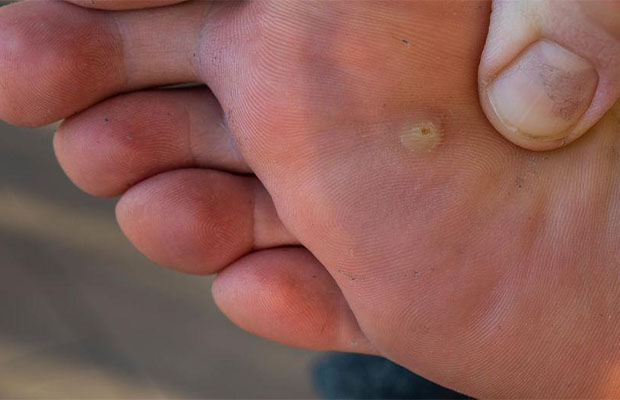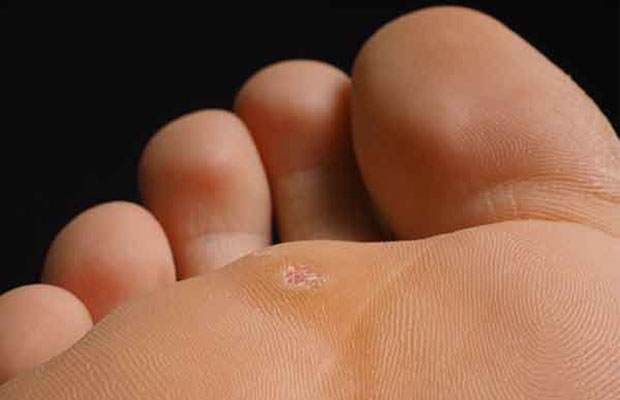Plantar Wart Vs. Corn: What Are The Differences?

what is the difference between a plantar wart and a corn? Learn more about their various causes and recommended treatment options by using this guide.
Plantar warts and corns can be unsightly, as you probably already know. Both can grow on the feet. Even medical professionals have trouble distinguishing between them due to their similar appearance. Warts and corns aren’t the same things, despite their similarities.
If you have persistent foot pain, it’s especially crucial to understand how to correctly diagnose and treat these conditions.
Table of Contents
What is a Plantar Wart?
The human papillomavirus (HPV), which enters through cuts or weak spots on the body, is what causes plantar warts. When it comes to the feet, plantar warts typically show up at the base of the toes or the heel and resemble small, fleshy, grainy growths. Plantar warts can grow inward and develop a callus over an area that has been worn down because the bottom of the foot is subjected to a lot of pressure.
Other ways to determine if you have plantar warts include:
- ache while moving or standing.
- A growth of black pinpoints or dots is present.
- Clusters of the growth appear.
Both direct and indirect contact can spread the contagious virus that causes plantar warts. Sometimes it takes up to six months for plantar warts to develop after virus exposure. Additionally, not everyone who has been exposed to the virus grows a wart. The virus may be able to be fought off by people with robust immune systems.
How is a Plantar Wart Diagnosed?
One of the best ways to find out whether you have plantar warts on your feet is to seek a diagnosis from a doctor. Your foot will be examined by this expert, who may also scrape the lesion with a scalpel. A dark pinpoint spot, which is a result of tiny blood vessels clotting, may also be looked for by the doctor. The doctor may cut out a small portion of the lesion and send it to a lab for testing if they think you might have warts.

How To Treat Plantar Wart?
Even though it might take one or two years, some plantar warts are harmless and will disappear on their own. However, if you find that your warts are painful or are beginning to spread, reach out to a doctor who might prescribe one or more of the following:
- Salicylic acid: This wart treatment with a prescription strength removes the wart in layers. Additionally, it might boost your immune system so that it can prevent the wart from spreading. Most likely, your doctor will advise applying this medication to your wart at home, followed by sporadic office visits.
- Cryotherapy: Cryotherapy typically involves using a spray or cotton swab to apply liquid nitrogen to the wart in the doctor’s office. Since this procedure can be painful, some patients request an area numbing beforehand. The dead tissue will start to peel off within a week or so after the nitrogen forms a blister around the wart. Your immune system may be boosted by cryotherapy to stop the spread of the wart. Until the wart is gone, you might need to come back to the office every two to four weeks for additional treatment.
- Immune therapy: The doctor administers medications and solutions to boost your immune system so it can stop the wart from spreading.
- Laser treatment: These procedures seal off tiny blood vessels, which eventually kills the infected tissue and makes the wart fall off.
What is a Corn?
A foot corn, as opposed to a plantar wart, is a thick layer of skin that grows on your foot as a result of ongoing friction and pressure. They frequently appear on the feet and toes. The typical characteristic of a corn is a raised, hard bump surrounded by flaky, dry skin.
Furthermore, corns are not contagious and are not a result of a virus, unlike plantar warts. Instead, they are brought on by wearing shoes that are either too tight or too loose, which causes your foot to experience excessive pressure or move around in the shoe. Additionally, they only develop on the foot, as opposed to plantar warts, which can develop anywhere on the body. There are three different types of corns:
- Hard: These corns are typically tiny, dense patches of skin that are contained within a larger patch of thickened skin. On the tops of the toes, hard corns are probably present.
- Soft: These corns have a softer texture and are white or gray in color. Between the toes is typically where soft corns are found.
- Seed: These tiny corns are typically found on the soles of feet.
How is a Corn Diagnosed?
A physician can help you identify corns on your feet and rule out other potential causes of pain. If you want to know if the corns are brought on by a physical anomaly, you might need to get an X-ray.
How To Treat Corn?
Eliminating the source of friction and pressure is one of the first things you should do when dealing with a corn. So, you must prioritize finding shoes that fit. For added comfort, think about slipping shoe inserts or pads inside your shoes. In order to soften the corn and smooth the skin, you could also try soaking your feet in water.
It might be time to see the doctor if your corn is hurting or you think the area has become infected. Your doctor might recommend the following:
- Trimming away the skin: A doctor might use a scalpel to remove the thickened skin from larger corns. Typically, this only requires one office visit.
- Surgery: The doctor might advise surgery if you have structural issues with your toes or feet. Bone tissue would be repositioned by the doctor.
Similarities and Differences
Warts and corns are similar in that they both:
- appear as small, rough skin growths
- can appear on hands and feet
- are painful and tender to the touch
Warts and corns are different in the following ways:
| Warts | Corns |
| Can appear anywhere on the body | Only appear on the feet |
| Have grainy bumps with black pinpoints | Are hard, raised, and flaky |
| Are caused by a virus | Are caused by friction and pressure |
How to Prevent Warts and Corns?
Preventing Warts
Stay away from the virus directly to prevent developing a wart. Wart-carrying individuals shouldn’t be held or shaken hands with. Do not use nail clippers, nail files, or pumice stones that have been used on someone who has a wart.
Avoid picking at warts or biting your fingernails if you have them. This might spread the virus to different areas of your body.
Preventing Corns
Make sure your shoes fit properly to avoid developing a corn. Your shoes ought to allow you to move your toes. If not, the footwear is too small.
Your shoes are too big and you need a smaller pair if your feet slide around in them.
Takeaway
Even though they can look alike, warts and corns are two different kinds of skin growths.
Knowing the distinctions between these two growths not only helps you determine whether you have HPV but also offers hints on how to treat them. If this is the case, you can take action to control your symptoms and stop the spread of the infection.
More To Read:
Tags: Corn, Plantar Wart